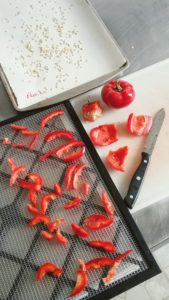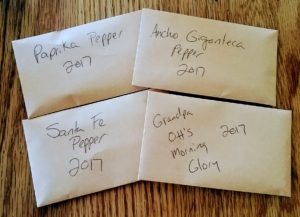This is always a busy time on our farm. The garden is at peak production and I try to preserve any produce left over at the end of our market days. On days the stand isn’t open, I’m usually found in our processing kitchen making jams, salsas, pickles, and more. There are also plenty of other projects that need our attention, so I make a list and prioritize what needs to be tackled each day. It’s easy to let next year’s garden wait until later, but it’s actually a crucial time.

It’s easier to make time to save seeds if you incorporate it into other tasks, like prepping peppers for the dehydrator.
I love growing heirloom plants, and one of the many fantastic things about heirlooms and open-pollinated varieties is that you can save the seeds year after year. This enables us to be a bit more self-sufficient, keeps our spring seed order costs down, and does a small part to help preserve the genetic diversity of the crops we grow. Some seeds are more complicated to save than others. Things like winter squashes easily cross-pollinate, which can result in funky, even inedible hybrids the following year. While there are ways to hand-pollinate for true seed, I also know that there are only so many things I can do and still do them all well. Currently, I focus on things that are simpler to save like peppers, beans, and tomatoes, or things that I grow only one variety of, like ground cherries or calendula. I grow more than one variety of crops like tomatoes and peppers, so I am mindful about seed saving while planting, which makes picking easier, too. I plant blocks of one variety. I alternate with other crops that will not cross pollinate. This helps to keep my seed stock pure for the next growing season.
Time management is one of the most important skills to master on a homestead, so this time of year I try to work saving seeds into other projects. If I’m making hot pepper jelly or prepping paprika peppers for the dehydrator, it takes just a few moments more to save seeds while I’m chopping. If I hit a slow spot in a weekday farm stand, I can be in the front yard harvesting spent zinnia blooms or morning glory seed pods. Sometimes, I just want useful projects to tackle on the last warm, sunny days of the year. I collect sunflower seed heads for planting next year as well as to feed our flock over the winter. Gathering seed from spent blooms is a great way to feel productive and savor some of the sun’s warm fall rays. With most crops, I spread the seed out to dry on freezer paper marked with the variety. When dry, I store it in #3 coin envelopes I found at a local office supply store. I write the variety and year saved on the outside with a pen.

I save flower seed as well as seed from vegetables and herbs.
Saving seeds is important for multiple reasons. Since I start all my own garden seedlings, any seeds I can save reduces the number of seeds I have to buy. It can increase the number of seedlings I’m able to start. This helps to have extra seedlings to sell as bedding plants. Reducing late winter expenses when seeds need to be ordered by saving my own seed is like putting money in the bank. I also find it’s easier to budget to try a few new varieties of vegetables each year. It helps me experiment and find out which heirlooms do best here. Every heirloom variety was developed in a specific place for a specific use or flavor. Not all heirlooms will do well in a specific place. However, every place is perfect for certain varieties. The trick is in finding a good match. Some varieties are more forgiving than others. Trying new varieties each year lets us try new flavors and see if we can find varieties that are perfectly suited to our farming methods and climate.
Another great reason to save seed is to help preserve the genetic diversity of our food crops. Saving your own seed means if your usual seed catalog stops carrying it, you can still plant the varieties that you love. Saving the seed from your most productive plants means you’re selecting for the version of that veggie that produces best at your particular farm over time. Relying on just a few varieties, like in industrial agriculture, makes the food system more vulnerable to a new disease or pest. This can have devastating consequences- relying one one variety of potato resulted in the crop failure known as the Great Potato Famine in Ireland. Lots of pockets of seed savers with genetically different varieties are likely to find at least one that shows resistance to any given crisis.
Heirloom varieties also tell a story. I raise a bell pepper that was grown at Monticello. These are not only edible pieces of history, there is also a market for them. Consumers want to connect with their food. They want you to go a step beyond the label “heirloom” and tell them what it means. Whether it’s a lettuce that has been planted in the United States since the time of the Civil War or a tomato that was commonly a Midwestern wedding gift, these are great stories to share and engage your customers.

It’s important to label not only what kind of seed, but when it was harvested.
I enjoy saving seeds and try to make it a priority when the time is right. It’s certainly been a boost to our bottom line. We’ve been able to greatly increase our production of garlic, among other crops, because we can save more seed than we could afford to buy. It’s a privilege to help steward rare varieties and help bring them back from the edge of extinction. Our customers love being connected to the deep roots of the food we grow. Much like orderly rows of things I’ve preserved from the garden, these little envelopes are the evidence of a good harvest. But also, the promise of harvests yet to come.











1 Comment
Loved the entire article. It helped me so much with choosing my seeds for next year. Thank you, thank you